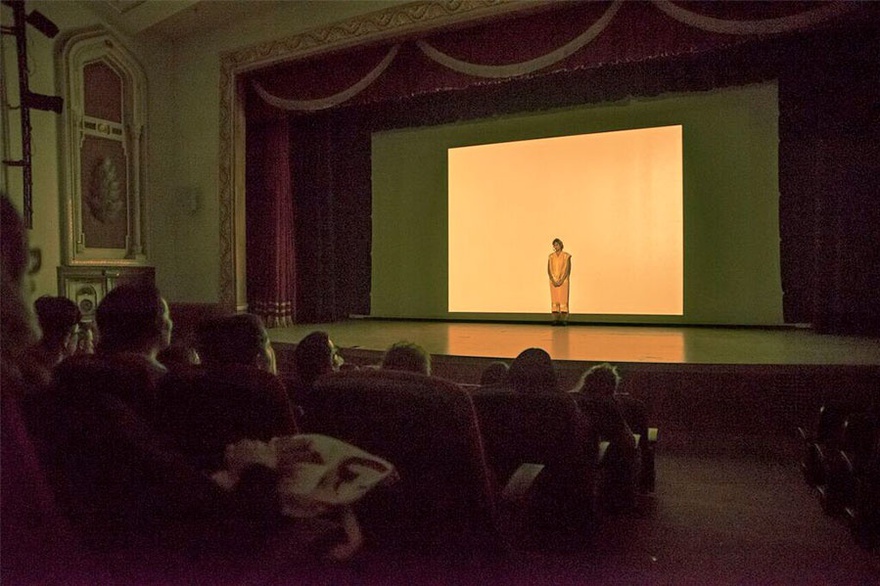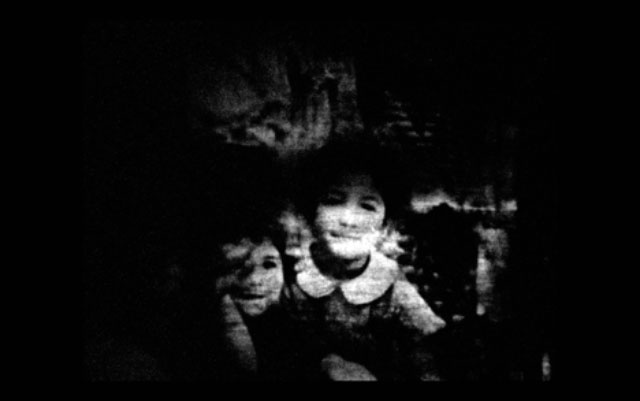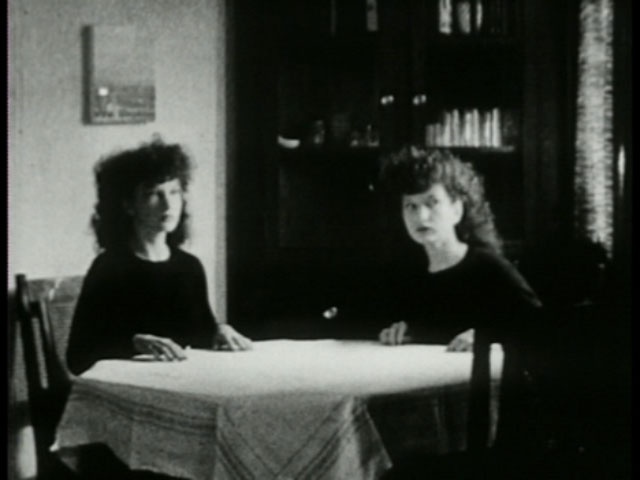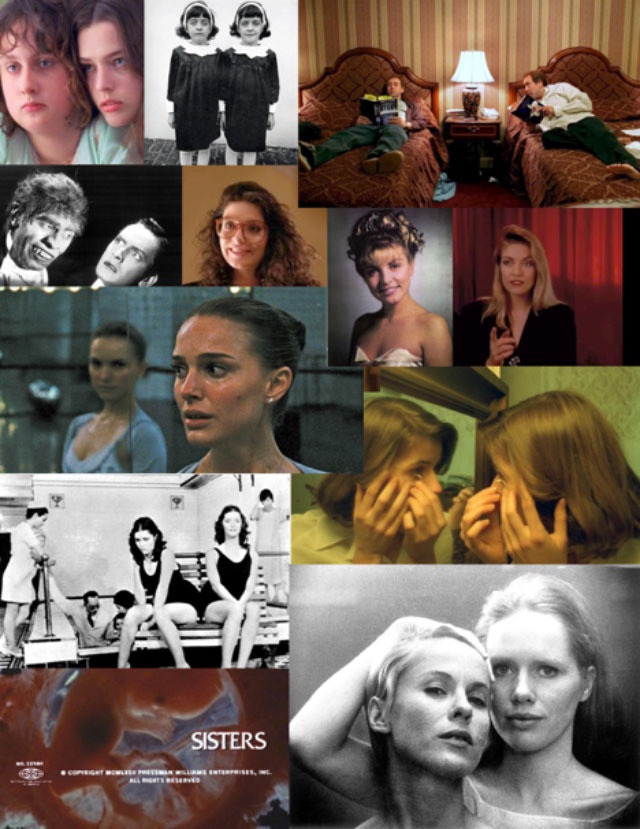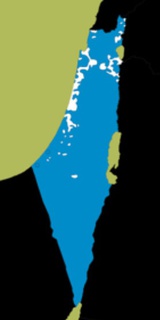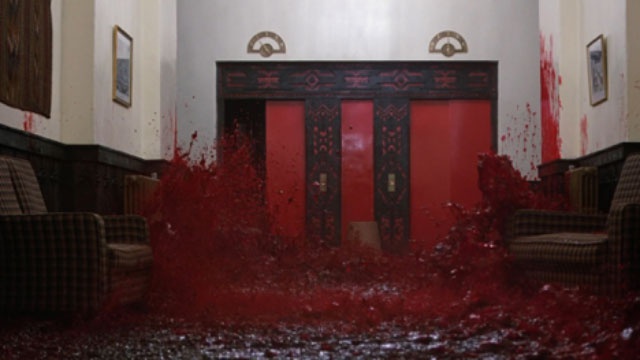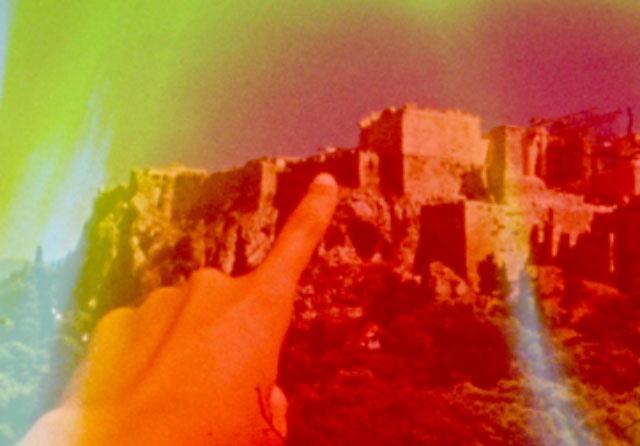Projects
Doppelgänging
Doppelgänging is a story told in a cinematic space.
It is an invitation to an experiment in voluntary collective memory.
Over the course of 45 minutes, this piece proposes to weave together the Occupation of Palestine, narrative cinema, and the possibility for Utopia.
The following text, images, and film clips are reconfigured here from the original work performed first at:
the Berlin Documentary Festival 3 in Germany, curated by Hila Peleg (2014), and then for The Time is Out of Joint in Sharjah, UAE, and Gwangju, South Korea, curated by Tarek Abou El Fetouh (2016)
*A NOTE FOR THE FULL EFFECTIVENESS OF THIS TEXT:
THE CONTENTS IN [ ___ ] ARE EITHER INSTRUCTIONS FOR YOU, THE READER, OR VISUALS RELATED TO THE ORIGINAL PERFORMANCE. IT IS BEST TO WATCH THE LINKS IN FULL SCREEN WITH HEADPHONES.
PART I. THE ANECDOTE
I'd like to start with an anecdote.
Something that my friend, Diego Marcon, shared with me.
I'll try to recount it as close to how it was told to me:
A couple of years ago,
I was invited to a workshop on Post-Internet art.
It was organized by a group of artists who were born, more or less, in the 1970s. All the participating artists were making work around this subject, like videos from the deep web, hentai stuff, people smashing washing machines, computers, or dressed up as dolls.
On the night of an open studio in this very beautiful old building in a posh part of Rome,
there was a girl on a visit to Rome,
who had tagged along, like a guest in someone's house.
She was from the United States, and when she introduced herself and said her age, it was done in a way that seemed like she had not yet turned 18 but would soon enough.
After some time, one of the artists asked her opinion of the workshop.
The girl answered:
'Me and my friends don't give a fuck about this.'
[PAUSE FOR A MOMENT]
PART II: AN AUTOBIOGRAPHY OF SOMEONE ELSE
It should take you about 25 minutes to read this.
You will find visuals throughout,
mostly moving images, or still images that appear to be moving,
in addition to 13 still images that are definitely not moving.
If you decide to stop reading this early, you will definitely not reach the end, and I will have no idea whether or not you have read it, unless you decide to share this with me.
That said, you are in fact completely free to do as you please.
I also want to note that I will begin with a semi-autobiographical narrative that is not entirely true and it will sound as though I am referring to someone else.
The point of this exercise is not to identify with each other as a group but rather to dis-associate from ourselves, our bodies, in order to come back to each other again,
in an entirely new space that we'll create together.
[PAUSE FOR A MOMENT]
Sometime at the end of November 1982, a man and a woman, both Palestinians, find themselves in Olympia, Washington. They are coming from Egypt, where they have finished school, and are essentially trying to immigrate to anywhere that will take them.
* it is their first time in America
* it rains all the time
* they are in the middle of the woods
* neither the man nor woman speak English very well
* their only neighbours are an elderly couple, who are very kind but also very hard of hearing.
The prospects of returning to Palestine are bleak,
so they begin to explore alternatives when Olympia doesn't seem to be working out,
eventually returning to the Middle East when their tourist visas expires.
The man from Tulkarem grew up in Kuwait.
The woman from Gaza spent her adolescence in a boarding school in Jerusalem.
The man is blacklisted over some vague connection with the PFLP (the Popular Front for the Liberation of Palestine).
When they first journeyed over to America from Amman, Jordan, where they first attempted to settle unsuccessfully, they flew British Airways, transiting in London, where, upon arrival on the tarmac, they were handcuffed on the plane and placed in holding cells overnight until they were finally released because, well, they hadn't done anything.
Anyways, it didn't work out in Olympia so they were on their way back to Amman, Jordan, transiting in New York when the woman realizes that she is pregnant.
So they headed to Kuwait, where the man's family is still living, and gave birth at the end of a long summer of trying to figure out where to go next.
The man and woman end up moving to Brittany, France, two months after the baby is born, and live there for 7 years.
They learn the language and finish their studies to begin practicing medicine and give birth to another child, when they are denied permanent residency.
It is now the early 1990s.
The man had Jordanian citizenship through his family, when Jordan took over the West Bank, but the woman had nothing. She was born in Gaza and had some kind of travel document in the form of a Laissez Passer until she married and her name was added to the bottom of the man's passport like a plus one to someone's wedding she wasn't personally invited to.
So they headed once again to America, where the man's family had since retired, and they all eventually became American citizens in 1996.
Throughout this time, the woman continued to return home to Gaza. And here's where it gets complicated:
Initially the woman would fly to Amman,
spend a few days,
cross the Allenby Border from Jordan into Israel,
and then spend a few days in the West Bank before heading south to Gaza.
When she became an American citizen,
she would fly directly into Tel Aviv,
spend a few days in the West Bank,
and then head south into Gaza.
Her and her daughters would sight see in Jerusalem,
visit relatives in Ramallah, Nablus,
and, on the occasional trips the man made back to Palestine,
they would visit Tulkarem.
Once, just after Oslo, they even went into Yaffa and Haifa.
In the early 2000s, with the second intifada, things began to change.
The woman, with her daughters, when landing into Tel Aviv,
would now receive a permit indicating that they should head directly for Gaza upon landing
as the permits were time sensitive and allowed only enough time to drive from the airport to the Gaza Border.
And finally, it was no longer even possible to land in Tel Aviv, or receive a permit, as anyone with an Israeli issued Gaza ID card was basically restricted because of security measures.
Travel into and out of Gaza became increasingly difficult, and sometimes altogether impossible as sanctions, and border closures, war, and the withdrawal of the Israeli Settlements that surrounded Gaza turned it into the open-air prison it is today.
The three still managed to continue visiting Gaza, though more sporadically now.
It was, after all, where the woman's entire family was still living.
The operation is believed to have been a joint National Military Organization:
Stern Group enterprise undertaken with the knowledge of the Haganah.
The deaths of some 250 Arabs – men, women and children –
which occurred during this attack, took place in circumstances of great savagery.
Women and children were stripped, lined up, photographed, and then slaughtered by automatic firing, and survivors have told of even more incredible bestialities.
Those who were taken prisoner were treated with degrading brutality. Although the Haganah is unable to deny that it gave covering fire to the terrorists responsible for this outrage, the action as a whole has been condemned by the Jewish press and denounced by the Chief Rabbinate.
Owing to other preoccupations, the Security Forces were not in a position to act before the 14th of April, for which day an air strike at Deir Yassin was arranged.
The Government of Palestine reported, on the 14th April, that it had not yet been possible to enter Deir Yassin and that a Jewish Police Officer sent to investigate was not allowed by the Haganah to proceed beyond Givat Shaul.
A representative of the International Red Cross who visited Deir Yassin on the 11th of April is said to have stated that in one cave he saw heaped bodies of some 150 Arab men, women and children, while in a stronghold a further 50 bodies were found.
The village was expropriated.
Stories of the atrocities in Deir Yassin helped trigger the 1948 Palestinian exodus.[1]
[PAUSE]
[NOW CONTINUE READING]
Sorry. This isn't – I don't know where that came from…
Our story was interrupted. So, let's just skip ahead to something more interesting than the details of Israel's occupation of the Palestinians through a brutally oppressive, apartheid state.
And let me summarize the story of the man and woman.
It is a story that involves circumstance, history, and the present, all-colliding together to fit into the collective memory of exile.
There is an impossibility that comes with collective memory.
The impossibility of forgetting.
The nature of the Israeli occupation of the Palestinian people is not so much defined by its injustice.
There is a lot of injustice in the world.
The occupation has more to do with an insistence that Palestinians must not forget that they do not belong in Israel. They are not allowed to forget, whether they are second-class citizens, occupied, in exile, or refugees. Palestinians share in an involuntary collective experience of trauma that both reminds them of what they do not have, and defines them as Palestinians.
When we are reminded of what we have lost, what we do not have, where we are not wanted:
it asks us to stay in the past.
Every time we drag an irreconcilable history out of the ground it is as though we are dragging a corpse buried long ago and confronting it with the present. Parading it around with it's flaccid limbs, and pretending that, if the others would just acknowledge that the corpse could come back to life, then it might actually happen. Like a scene from a horror film, in which the protagonists don't yet know that they are ghosts.
I am not trying to suggest that we forget any kind of trauma that has been directly inflicted upon us, or even that which has been passed down.
But I am wondering about the image that this trauma creates in our minds – our subconscious that we find in someone else's image of violence or trauma. In the moment that we look at a violent or a repulsive image, or an image of desire, we enter into a void. Not physically, but like a double entering into another world. One in which we cease to exist and the subject that is represented ceases to exist. And in this void, we bond. We have a shared experience, with the subject on screen, with the person sitting next to us, et cetera.
This image comes into existence for us. This image has been recorded for us. And once we leave this void, and return to the comfort of our seats, to our bodies, in our homes, in a cinema, in bed, we experience a kind of satisfaction by having felt sadness, or repulsion, or desire at what we have just witnessed. We have been moved without moving.
[LINK TO VIDEO: https://vimeo.com/106173085/bf85ee323b 'O, PERSECUTED', 11:38]
PART III: DOUBLES
So let us shift our gaze to narrative cinema.
That highly immersive environment that we share in collectively.
In Maya Deren and Alexander Hammid's film: Meshes of the Afternoon, a surreal narrative plays out in a repeating dream-like cycle where the main character, playing multiple selves, commits a murder.
[LINK TO VIDEO: https://vimeo.com/165188996/b8e8a95981
EXCERPT FROM 'MESHES OF THE AFTERNOON', 4:20]
Brian De Palma's psychological horror Sisters, introduces us to two characters, Siamese twins, separated at birth: one successful, the other morose. The bad sister murders the good sister's love interest and by the end of the film, (and yes, I'm going to ruin it for you) it is revealed that one of the sister's died when they were separated at birth and the evil twin is perhaps a split personality disorder.
In Bergman's film Persona, a nurse is put in charge of a catatonic actress, who has suffered a nervous breakdown. Over the course of their time together, the nurse tends to the silent actress, speaking to her every day, revealing things about herself. The nurse's identity begins to submerge into the actress and the two women become one person.
While in Breillat's film, Fat Girl, two very different sisters experience a coming of age in radically different ways. Tumultuous and complicated, pitting the two against each other radically disrupts our understanding of female sexuality.
– The self-loathing man and his idiot twin, who resolve their differences in order to survive.
– The high school beauty queen who is murdered and then reappears as different characters, in a series that explores the good and evil that exists in all of us.
– Dr. Jekyll and Mr. Hyde.
– The double whose sadness is passed onto us.
– The black swan that is taking over.
Or very simply:
– The uncanny twin.
Narrative cinema relies on the trope of the double to tell of the struggle between good and evil.
To signify an inner turmoil, a personal struggle, a conflict that the protagonist must resolve by the end of the film, or else suffer their own demise.
PART III: THE DISAPPEARING MAP
So now, perhaps we can move away from Either/Or,
here and an elsewhere, two-state, a co-existence, separate but equal.
And talk about duality.
Instead of looking at a place as only having enough room for one people,
let's think of ways that a people are able to be in two places at the same time.
Rather than defining identity based on denial and loss,
let's define ourselves through agency.
The idea of being in two places at once, or even just the possibility of it, is something that we all practice in one form or another, and I want us to find a way to experience the present, without a past.
And, since collective memory is something that can be passed down, then maybe it is something that we can create together voluntarily.
So let's first return to Palestine:
Is it a place? A history? A people?
Is it the land before the British Mandate and the Ottoman Empire? Does it belong to Napoleon's descendants?
Is it Syrian? Is it Roman? Is it Canaanite?
Is it the Holy Land? Is it the Promised Land?
All we know for sure, is that it is LAND.
In its contemporary context,
it is a land partitioned in 1947;
annexed in 1948;
and occupied in 1967.
It is a place that is steadily disappearing for the Palestinian population and continuing to grow for the Israeli population.
For the massive diaspora, refugee population, and those in exile, Palestine reaches far beyond the borders of its territory.
So, perhaps we should try to go there without actually physically going there.
[WATCH AS MUCH OF THE VIDEO AS YOU POSSIBLY CAN.
LINK TO VIDEO: https://vimeo.com/165189601/3d88d9fdbf, 5:57]
The kind of out-of-body experience that is achieved through something called bilocation is the phenomenon of being in two places simultaneously.
One in which perception is moved outside of the body.
Instead of physically being and moving around in two places at the same time, we experience a multiplicity of perspectives.
Perhaps the most common example is: the Lucid Dream.
(When you are aware that you are dreaming and can control what you are doing in your dream.)
Most who practice it today report something like a flying dream,
a hallucination,
a psychic or a mystical experience of some kind.
In one example:
The ancient Finns believed that people had multiple souls.
One of these:
The It*say-soul was thought to be the actual 'me' of the human being.
In modern Finnish it*say is a pronoun for 'myself'.
One could lose one's itse, a catastrophe that would render the person
itse-tön (itse-less).
An 'itsetön' person was sickly, pale, depressed and unlucky.
Soul-loss might also cause the person to become paralytic, epileptic or an alcoholic.
In this case, a kind of Shaman would travel in search of the lost soul.[2]
If we return to the moving image, what we are watching belongs to a different time than the time that we exist in.
We suspend our disbelief and a day is portrayed in the span of a few minutes or seconds.
An entire lifetime or decades pass under a few hours.
We are in the space of a projected image that exists only fast enough for us to perceive that it is moving, while we are equally conscious of where we are physically. We are in the void and in the cinema at once.
Take when you jump during a suspenseful scene,
when you cry at the death of a hero,
when you are aroused by a sex scene.
There is also the duality that I believe exists in all of us.
Our self-image versus how others perceive us (which is different between those who know us, and strangers); and the self which history and/or genetics has pre-determined. Beyond all of this we are multiple selves to our selves that are not necessarily battling each other but multiple selves that coexist.
While it is interesting to think about how this might affect us as individuals, it is on a collective level where it begins to move and shift the world forward or back.
If we collectively move away from how we have been imagined to exist, how others have imagined us to be, and how history has determined who or what we are, and we become mutable, multiple, and everywhere without moving, then perhaps we start to regain our agency.
The trauma of knowing that we are not unique, that our experience is not singular – that somewhere lurking in the shadows is our double, our twin, who slowly but surely is there to take over our precious life, is something we perhaps all live with inside of ourselves. This other person, this mirror of who we think we are, manifests in ways that are beyond our control.
But haven't we established that there is pleasure in the battle? Isn't that the best part of the film? Once everything has been resolved, isn't the film over? To be clear, this isn't some lame metaphor for Palestine and Israel. It is a proposition about first: individual inherent pleasure in doppëlganging – to being ourselves in multiple forms. And that as a collective of doppëlgangers, the multiplicities that we create allow us to exist as something that goes far beyond frontiers of any kind.
What I want to try to do with you relies on the space you have created around you through the reading of this text.
The focus you have given to these words in order to follow the windy road that you have been taken on ends here, with hypnosis.
To explain: hypnosis is defined as a kind of 'Non Space': one that does not exist in reality (like the cinema). A space in which we are not fully here, nor fully there, but in both places, at once, consciously subconscious.
In this space, which is necessarily always in the present and always moving forward, the past recedes and the future is empty. What is lost is in the past. What is in the past is lost. Perhaps in this brief, ephemeral space, this utopia, when we slip into the image, when we become two dimensional, we regain our vision and are no longer subjects; we are free to confront the future as it rushes towards us.
[PAUSE FOR A MOMENT]
PART IV: THE OVERLOOK HOTEL
I want to conclude with a reassuring note without much explanation: that I do not believe we can actually shed history or trauma voluntarily, nor do I want this. But I do want more voluntary collective experiences with people I will never meet.
Before concluding, let's revisit Kubrick's film The Shining.
[LINK TO WATCH 'THE SHINING PREVIEW' https://vimeo.com/165191321/2480141f42
TOTAL LENGTH, 1:36]
In Stanley Kubrick's interpretation of The Shining, the Overlook Hotel is built on a Native American burial ground.
As a reminder of the film: a family – Mother, Father and Son – have agreed to watch over a hotel in the Colorado mountains during off-season, when the area is deserted and completely snowed in. In exchange, they stay free of charge and have access to the entirety of the lavish hotel. They are shown living quarters but told they have a run of the entire property since they'll be the only ones there.
The characters, in isolation, find themselves haunted by a past that eventually drives them mad.
A past that is not their own,
but one they cannot escape if they actively deny it exists.
They hallucinate the hotel elevators sinking deep into the graves of the Native Americans; blood gushing down corridors, flooding the space.
And throughout the film we see the double appearing in various forms:
the slaughtered girls who are not twins but are dressed identically to each other, mirror Wendy Torrance, the mother.
While Jack, the father, appears to exist in two different eras (the one of the film and as a character in the history of the hotel).
So maybe, we are all some form or character that is the American family staying at the Overlook Hotel,
haunted by a past we cannot repress,
will never be able to justify,
and that will destroy us unless we acknowledge it is there,
that it is real,
and that we have to find a solution before it kills us all.
PART V: VOLUNTARY COLLECTIVE HYPNOSIS
Now for the end:
In a field under the sun, where you are not alone because you can see the shadow of another beside you, the dried out earth, two ships, a horse running through an orchard, you point at the ruins of civilization...
[LINK TO WATCH 'DEEP SLEEP' https://vimeo.com/101257097 TOTAL LENGTH, 12:45]
DOPPELGÄNGING
Writing
Basma Alsharif
Films
O, Persecuted, Basma Alsharif, 2014 (excerpt)
Deep Sleep, Basma Alsharif, 2014 (full)
Additional Footage in 'O, Persecuted'
Our Small Houses, Kassem Hawal, 1974
Boubouka Pappas
Israeli women Beautiful Eilat and Tel Aviv nightlife
Stills:
Catherine Breillat, Ma Soeur, 2001 (film)
Diane Arbus, Identical Twins, Roselle, New Jersey, 1967 (photography)
Victor Fleming, Dr. Jekyll and Mr. Hyde, 1941 (film)
David Lynch, Twin Peaks (television series)
Darren Aronofsky, Black Swan, 2010 (film)
Brian de Palma, Sisters, 1973 (film)
Krzysztof Kieślowski, La double vie de Veronique 1991 (film)
Ingmar Bergman, Persona, 1967 (film)
Spike Jonze, Adaptation, 2002 (film)
Excerpts from
Meshes of the Afternoon, Maya DEREN & Alexandr HAMMID, 1943
The Shining Official Trailer (1980) Stanley KUBRICK
Music
RIOT NATION ABBA GABBA
Additional Sounds
Theta Wave Binaural Beat Frequency
References
Finnish Paganism by Anssi Alhonen (2008)
http://www.mosmaiorum.org/finnish_paganism.html
Foucault, Michel (October 1984). "Des Espace Autres". Architecture, Mouvement, Continuité. 5: 46-49.; it has been translated into English twice, first as Foucault, Michel (Spring 1986). trans. Jay Miskowiec. "Of Other Spaces". Diacritics.16 (1): 22-27.
With Support From
Berlin Documentary Forum 3
Sharjah Art Foundation, UAE
Asia Culture Center – Theater, Korea
Palestine Film Foundation
Galerie Imane Farés
Malta Arts Fund
LabA Athens
Special Thanks To
Hila PELLEG
Tarek ABOU EL FETOUH
Vassily BOURIKAS
Josh BONNETA
Emma MATTEI
Ben RUSSELL
Slavko VUKANOVIC
Stephanie BAILEY
_
_
_
.
[1] The Foreign and Commonwealth Office Archive: FCO 141/14284 filed on 10 April 1948 as part of a collection of weekly intelligence reports from the High Commissioner for Palestine to the Colonial Secretary in London. Courtesy of electronicintifada.com.
[2] Finnish Paganism by by Anssi Alhonen (2008) http://www.mosmaiorum.org/finnish_paganism.html

